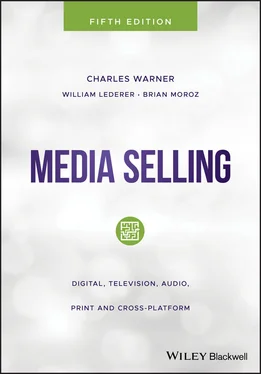1 ...8 9 10 12 13 14 ...36 It is estimated that by 2020 the vast majority of all media advertising will be automated – bought and sold programmatically – which means that the negotiating and transaction phase of the media buying and selling process will be done by algorithms in an artificial intelligence (AI) application, not by humans. Therefore, the nature of media selling will change as automation does many of the routine tasks involved in the prospecting, qualifying, researching, proposing, negotiating, and transacting phases of selling as well as the planning and executing of media buys done by marketers and ad agencies. Media selling will become more about educating marketers and media planners about the advantages and benefits of a medium or platform during the planning stage of advertising campaigns. It will be about coming up with innovative ideas regarding targeting, optimization, creative executions, promotions, endorsements, and events that appeal to a medium’s specific audience and about connecting emotionally with everyone a salesperson calls on.
Assumption 3: The explosion of complexity makes media selling difficult
There are two main drivers of complexity in selling digital advertising: (1) the marketing ecosystem is more complex and (2) digital ad targeting adds even more layers of complication.
First, the marketing and advertising ecosystem has become infinitely more complex, as visualized in the Display LUMAscape graphic available at https://www.lumapartners.com/luma‐institute/lumascapes/display‐ad‐tech‐lumascape/.
The graphic shows the number of service companies that come between marketers such as P&G, AT&T, Amazon, and Ford and publishers such as The New York Times , The HuffPost, and NPR. These businesses include:
Advertising agencies
Retargeting companies
Ad Servers
Verification/Privacy companies
Agency trading desks
Creative optimization companies
Demand‐side platforms (DSPs)
Media planning and attribution companies
Measurement and analytics companies
Exchanges
Data‐management platforms (DMPs) and data aggregators
Data suppliers
Ad networks (horizontal, vertical, and custom targeted)
Performance and optimization companies
Data‐sharing and social tools
Supply‐side platforms (SSPs)
Publisher tools companies
Media management systems and operations companies
All of these businesses need salespeople who understand both the digital marketing ecosystem and the personal needs, problems, and challenges of media buyers, prospects, customers, and partners.
Second, the switch from broadcast, print, and US Postal Service distribution to Internet distribution has dramatically increased the amount of data available to marketers and, thus, has dramatically increased the ability of marketers to target individual consumers rather than advertise on traditional media like television or radio to broad demographics such as women 18–49. Cookies on web browsers, location data on smartphones, and the Internet Of Things (IOT) – chips in packages, in boxes of food, or in clothing – give marketers mountains of data to use to target specific individual consumers, for example a 34‐year‐old single woman who has recently looked online for outdoor camping equipment, who lives in the state of Washington, who uses one or more dating apps such as Tinder or Match.com, and who is planning a camping trip on a weekend in the next three weeks. Behavioral, life‐style, location, purchase intent, exact age, marital status, and much more data are available about anyone in the US or in the world who uses the Internet on a desktop, laptop, mobile phone, gaming station, or smart TV (smart TVs are connected to the Internet).
The explosion of specific data on individuals has replaced sizzle, magic, wild promises, and broad demographics as the currency in the media. Today virtually all media selling includes a digital component, so media salespeople must understand how digital advertising works and how it is created, purchased by auction, placed, targeted, served, tested, measured, and verified.
Assumption 4: Much of digital advertising is unpopular
In a January 31, 2018 article in The New York Times titled “Tackling the Internet’s central villain: The advertising business,” technology reporter Farhad Manjoo writes, “There’s a lot of dark stuff. In one corner, you have the Russian campaign to influence the 2016 presidential election with digital propaganda. In another, a rash of repugnant videos on YouTube…” 7 Manjoo further writes, “Then there’s tech ‘addiction,’ the rising worry that adults and kids are getting hooked on smartphones and social networks despite our best efforts to resist the constant desire for a fix.” Manjoo lays the blame for these problems on the advertising business. He suggests:
Ads are the lifeblood of the Internet, the source of funding for just about everything you read, watch and hear online. The digital ad business is in many ways a miracle machine – it corrals and transforms latent attention into real money that pays for truly useful inventions, from search to instant translation to video hosting to global mapping.
But the online ad machine is also a vast, opaque and dizzyingly complex contraption with underappreciated capacity for misuse…
Furthermore in 2018, a Kantar Millward Brown survey revealed that people believe digital ads are becoming more invasive. The study showed that 71 percent of respondents to the survey said that ads were more invasive than they were three years earlier. A similar number of respondents said they were seeing more ads overall, and even a larger percentage responded that they thought that ads were appearing in more places they visited. 8 So, consumers as well as media critics and reporters are attacking digital advertising, especially too much and too intrusive advertising.
Because of criticisms like that of Manjoo and of consumers, media salespeople, especially those selling digital media advertising, must make sure they are selling responsible, truthful, not overly intrusive advertising that appears in brand‐safe content and that they are closely adhering to the Five Cs of Ethical Responsibility, as defined in the Chapter 3of this book.
With these new assumptions in mind, let’s look at several approaches to successful media selling.
Approaches
An old approach that still works
The question most asked by beginning salespeople is, “Where do I start?” The answer is to start with the AESKOPP approach.
AESKOPP is a mnemonic that will help you remember the following elements of successful selling:
Attitude
Emotional intelligence
Skills
Knowledge
Opportunities
Preparation
Persistence
We will look at each element of the AESKOPP approach closely in Chapter 4.
New selling approaches for the digital era
Matthew Dixon and Brent Adamson’s 2011 book, The Challenger Sale: Taking Control of the Customer Conversation , was “the most important advance in selling for many years,” according to Neil Rackham the author Spin Selling , one of the most influential books ever written about selling, and the go‐to book for sales training until The Challenger Sale was published. 9
Dixon and Adamson were Executive Directors of the Corporate Executive Board’s (CEB) Sales Executive Council (SEC), and in 2009 launched
What was to become one of the most important studies of sales rep productivity in decades. Tasked by our members – heads of sales for the world’s largest, best‐known companies – we set out to identify what exactly set this very special group of top‐performing sales reps apart. And having now studied that question intensively for the better part of four years, spanning dozens of companies and thousands of sales reps, we have discovered four core insights that have fundamentally rewritten the sales playbook and let B2B sales executives all over the world think differently about how they sell. 10
Читать дальше












